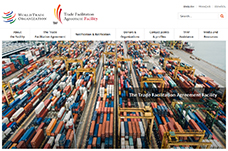MÁS INFORMACIÓN:
> Comunicados de prensa 2015
The TFAF was created at the request of developing country and least-developed country (LDC) members to help ensure that they receive the assistance needed to reap the full benefits of the Trade Facilitation Agreement and to support the ultimate goal of full implementation of the new Agreement by all members. The TFAF will support these countries in assessing their specific needs and identifying possible development partners to help them meet those needs through a diverse number of activities.
The Facility was formally launched on 22 July 2014 by WTO Director-General Roberto Azevêdo and became operational on 27 November 2014. The website can be accessed here in English, French and Spanish.
The Trade Facilitation Agreement broke new ground for developing and least-developed countries in the way it will be implemented. For the first time in WTO history, the requirement to implement the Agreement was directly linked to the capacity of the country to do so. In addition, the Agreement states that assistance and support should be provided to help them achieve that capacity.
To benefit from this, developing and LDC members must notify the WTO which provisions they will implement when the Agreement enters into force or, in the case of LDCs, within one year after entry into force (Category A commitments); which provisions they will implement after a transitional period following the entry into force of the Agreement (Category B); and which provisions they will implement on a date after a transitional period following the entry into force of the Agreement and that require the acquisition of assistance and support for capacity building (Category C).
The aim of the TFAF is to help ensure that this assistance is provided to all those needing it. The website provides background on the Agreement and the TFAF, information on programmes that support implementation of the Agreement, as well as information on national contact points for trade facilitation in developing and LDC members.
The website also provides information on TFAF support related to the preparation of Category A, B and C commitments, assistance and support for capacity-building, and applications for TFAF grants where no other funding sources are available to developing and LDC countries to meet their implementation needs. The website is a “work in progress” and will be continuously updated to provide useful information for WTO members.
Background
Concluded at the WTO’s 2013 Bali Ministerial Conference, the Trade Facilitation Agreement contains provisions for expediting the movement, release and clearance of goods, including goods in transit. It also sets out measures for effective cooperation between customs and other appropriate authorities on trade facilitation and customs compliance issues. It further contains provisions for technical assistance and capacity building in this area.
The Protocol of Amendment inserting the TFA into Annex 1A of the WTO Agreement was subsequently adopted by the General Council on 27 November 2014. This in turn opened the door for members to formally accept the TFA through their domestic legislative procedures.
To date, five WTO members — Hong Kong (China), Singapore, the United States, Mauritius and Malaysia — have secured domestic acceptance of the TFA. Two-thirds of the WTO’s 161 members will need to ratify the TFA in order for the Agreement to enter into force.
More information on trade facilitation and the TFA can be found at www.wto.org/tradefacilitation
Sitio Web del nuevo Mecanismo para el Acuerdo sobre Facilitación del Comercio
El sitio funciona como punto de coordinación para los Miembros de la OMC, donantes y otras partes interesadas que busquen información sobre el Mecanismo para el Acuerdo sobre Facilitación del Comercio.
> Si tiene problemas para visualizar esta página,
sírvase ponerse en contacto con [email protected], y proporcionar detalles sobre el sistema operativo y el navegador que está utilizando.

